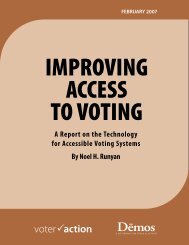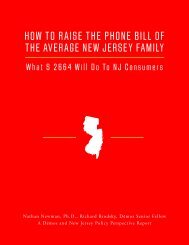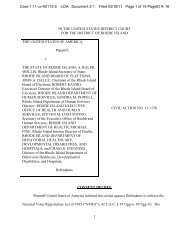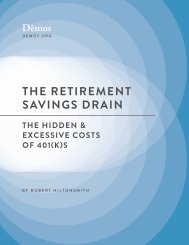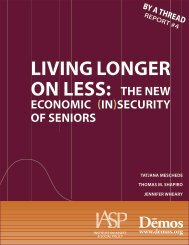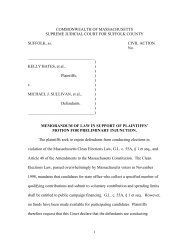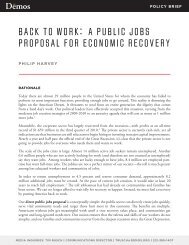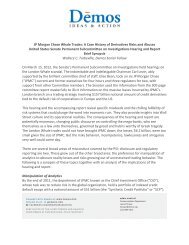The Foundations of Durable Racial Inequality, 1940-2013 - Demos
The Foundations of Durable Racial Inequality, 1940-2013 - Demos
The Foundations of Durable Racial Inequality, 1940-2013 - Demos
You also want an ePaper? Increase the reach of your titles
YUMPU automatically turns print PDFs into web optimized ePapers that Google loves.
transfers accounted for 15 percent <strong>of</strong> federal cash transfers; Social Security made up another22 percent. Means-tested transfers increased sharply during the recent recession but theuptick started in the early 1990s. Many policymakers favor means-tested policies becausethey believe such policies efficiently redistribute income to those in need and cost less thanpolicies with broader coverage. Such “efficiency” comes at a rather high price. Means-testedpolicies disproportionately benefit poor African Americans and Latinos—in 2004 theaverage monthly participation rate in means-tested programs for blacks was 37.1 percent,for Latinos 30.1 percent and for non-Hispanic whites 10.8 percent—but they are inherentlystigmatizing. Despite the U.S. preference for means-tested policies, the U.S. welfarestate does less to redistribute income and reduce inequality than European welfare states. In2004, taxes and transfers reduced income inequality in the United by 18 percent comparedto 40 percent in Denmark and Sweden, 31 percent in Germany, and 23 percent in GreatBritain (Immervoll and Richardson <strong>2013</strong>, 20).<strong>The</strong> third way race shapes the U.S. welfare state is via federalism. Unlike many Europeanwelfare states, the U.S. welfare state began, and in many respects remains, highly decentralized.State governments controlled eligibility criteria and benefit levels for unemploymentinsurance and until 1972 for all the cash welfare titles <strong>of</strong> the original Social Security Act.<strong>Racial</strong> discrimination in the administration <strong>of</strong> AFDC flourished in both North and Southfrom the 1930s to the 1960s (Lieberman 1998; Bell 1965). Things began to change in theearly 1970s with the growth <strong>of</strong> food stamps and the creation <strong>of</strong> the Earned Income TaxCredit, both national means-tested programs. <strong>The</strong> welfare reform law <strong>of</strong> 1996 further centralizedcontrol over federal social policy for the poor, yet states still retain wide leverageover social welfare policy.5Both the universal and segmented sides <strong>of</strong> truncated universalism operate to produceracial distinctions that shape how individuals are included in the welfare state and the kind<strong>of</strong> benefits they receive. One <strong>of</strong> the chief causes is racial labor market competition, whichaffects employment and wage levels and thus one’s relationship to the welfare state. <strong>The</strong> templatefor this was set during the Great Depression. White workers acted to displace AfricanAmericans from their jobs, in many case grabbing “Negro jobs” they had previously scorned.New Deal work relief policies compounded the difficulties facing black workers. BecauseWPA jobs were scarce—the WPA never covered more than 30 percent <strong>of</strong> the unemployed—blacks faced the same competition with white workers for WPA jobs as they did for privatesector jobs. Local <strong>of</strong>ficials and craft unions hoarded WPA jobs and excluded many blackworkers. <strong>The</strong>re was no nondiscrimination policy that would have prevented this (Brown, M.K. 1999, 68–70, 77–86). As blacks were denied work in the private sector or access to workrelief, they turned to the only available source <strong>of</strong> income: local cash relief. Relief rates forblacks in northern cities increased as unemployment declined in the late 1930s. Long ago,Gunnar Myrdal captured the essence <strong>of</strong> this process when he observed that whites coercivelysubstituted relief for jobs, relegating African Americans to stigmatized welfare rolls (Myrdal1944, 301). By denying access to steady employment, racial labor market competition alsoMICHAEL K. BROWN • 5
affects an individual’s eventual Social Security benefits and access to unemployment compensation.<strong>The</strong> problem, <strong>of</strong> course, is that this not only tilts welfare state benefits towardwhites, and thus is an element <strong>of</strong> the (until very recently) economic stability <strong>of</strong> most whiteAmericans; it also calls the legitimacy <strong>of</strong> the welfare state into question.In order to see how the relationship between labor market competition and the welfarestate unfolded for blacks and whites, we examine first the history <strong>of</strong> labor markets since the<strong>1940</strong>s and then the implications for the distribution <strong>of</strong> social welfare.OPPORTUNITY HOARDING AND RACIAL LABORMARKET COMPETITION SINCE THE NEW DEAL<strong>The</strong> last 73 years <strong>of</strong> economic history is usually divided into two periods—a prosperouseconomy <strong>of</strong> rising real wages and income among all classes and groups between 1945-1972,followed by 40 years <strong>of</strong> stagnating wages, particularly for non-college educated workers,and rising income and wealth inequality. All social classes rode up the income and employmentelevator in the 1950s and 1960s, and all but the top 10 percent or so languished on aneconomic treadmill going nowhere after 1973. Real family income for all income quintilesgrew, on the average, 2.2 to 2.5 percent in the first period, but in the second period thebottom 40 percent <strong>of</strong> the income distribution lost ground or faced stagnant incomes. Onlythe top 20 percent gained, yet even this group, on average, only gained about 1.2 percent.<strong>The</strong> real income gains in this period, it is well known, were grabbed by the top 1 percent <strong>of</strong>earners (Krueger 2012, figure 1). Similarly, both black and white workers prospered in thetwo decades after World War II and suffered from the six recessions and the deindustrialization<strong>of</strong> manufacturing after 1973. Yet neither the gains <strong>of</strong> economic growth nor the pain<strong>of</strong> recessions and economic change have been distributed equally among blacks and whites.Whether measured as family income or personal income, the wages and salaries <strong>of</strong> AfricanAmericans have lagged behind whites throughout both periods. <strong>The</strong>re is no doubtthat African Americans made real income gains during and after World War II. Real blackmedian family income doubled between 1947 and 1972, as did the median income <strong>of</strong> whitefamilies. Black families gained relative to white families; the ratio <strong>of</strong> median family incomeincreased to 59.5 percent from 51.2 percent. Yet the absolute median income gap betweenblack and white families increased over this period by almost $5,000, a 35 percent gain forwhites. In fact, blacks lost ground to whites by the late 1950s and only regained momentumduring the economically booming 1960s. After 1973, even though the median familyincome <strong>of</strong> both whites and blacks rose by a little over one-fifth, black family income stilllagged substantially behind Non-Hispanic whites. <strong>The</strong> ratio was unchanged: 57.4 percent in1973 and 58 percent in 2011. <strong>The</strong> absolute income gap also widened by another $5,000, andover the entire 73 year period this gap grew by 115 percent. Even so, these data overstateblack economic gains over the last 35 years since they exclude African Americans who wereimprisoned during the incarceration boom (Pettit 2012).6 • DIVERGENT FATES: THE FOUNDATIONS OF DURABLE RACIAL INEQUALITY, <strong>1940</strong>-<strong>2013</strong>
At the same time that blacks have made income gains, black employment relative to whiteworkers has decreased. Black men <strong>of</strong> all ages and education levels experience more unemployment.<strong>The</strong> black unemployment rate is twice that <strong>of</strong> white workers, a ratio that hasnot changed since the early 1950s. Between 1948 and 1969, black unemployment averaged8.4 percent compared to a rate <strong>of</strong> 3.9 percent for white workers. In 7 <strong>of</strong> these 22 years, theblack unemployment rate exceeded 10 percent. Black workers faced even worse employmentprospects during the 39 years after 1973: black unemployment averaged 12.3 percent;white unemployment averaged just 5.7 percent. During this period black unemploymentwas below 10 percent in only 7 <strong>of</strong> 39 years. Black workers have experienced what amountsto Depression-era unemployment for most <strong>of</strong> the last 4 decades (see Figure 1).6 Large numbers<strong>of</strong> black men have also dropped out <strong>of</strong> the labor force since <strong>1940</strong>, a development thatprecedes the deindustrialization <strong>of</strong> the American economy during the 1970s and 1980s(Katz, et al. 2005).Figure 1. Male Unemployment Rates by Race (16 Years and Older)252015105WhiteBlackLatino19731975197719791981198319851987198919911993199519971999200120032005200720092011% Unemployed0College-educated black workers, like their white counterparts, do have lower unemploymentrates than high school dropouts or workers with only a high school education. But theirunemployment rates are almost double those <strong>of</strong> white college-educated workers. Figure 2shows that the black unemployment rate is higher than the white rate at all educationallevels, and in the 1970s, the 1980s, and the recent recession the unemployment rate for blackcollege-educated workers was double that <strong>of</strong> college-educated whites. Indeed, in the recentGreat Recession, white high school graduates with some college had lower unemploymentrates than black college graduates; and as the economy improved after bottoming out in2009, white workers at all levels <strong>of</strong> education found jobs faster than black workers. <strong>The</strong> ratio<strong>of</strong> black unemployment to white unemployment increased between 2009 and 2011, a trendthat is identical to the experience <strong>of</strong> black workers in the late 1930s (Brown 1999, 84-87).MICHAEL K. BROWN • 7
Figure 2. Black-White Male Unemployment Ratios by Years <strong>of</strong> Education3.002.502.001.501.001967–691977–791987–891994–962007200920110.500.00
Those blacks who reached the Promised Land after the war confronted a more hostileeconomy and faced widespread discrimination. Migrating black sharecroppers were threetimes as likely to be unemployed in the north as white migrants. In fact, black residents <strong>of</strong>northern cities were more likely to be unemployed than white migrants (Sorkin 1969, 272).Black economic gains were further eroded as economic growth slowed in the late 1950s andtechnological change in manufacturing firms reduced demand for workers. As these factoriesreplaced workers with machinery, black workers lost out because the “jobs in whichNegroes were concentrated were eliminated and the displaced Negroes were not permittedto bid into or exercise their seniority in all-white departments.” (Northrup 1970, 26; Sugrue1996, 144). Notably, the sharpest drop in the labor force participation rate <strong>of</strong> black workersrelative to white workers during the last 73 years occurred in the 1950s. At the same time,blacks faced discrimination in openings for skilled craftsmen and white-collar jobs, both<strong>of</strong> which were expanding. <strong>The</strong> proportion <strong>of</strong> blacks employed as salaried workers declinedfrom 4.6 to 3.4 percent between <strong>1940</strong> and 1960 (Northrup 1970, 26).Educated blacks in the 1950s fared no better and their unemployment rates were typicallyhigher than those <strong>of</strong> blacks with less than 12 years <strong>of</strong> schooling. White workers, particularlywhite veterans, made the real income and occupational gains <strong>of</strong> the 1950s. Powered bythe G.I. Bill, one-third <strong>of</strong> the veterans who received educational and readjustment benefitsclimbed out <strong>of</strong> working class jobs into the ranks <strong>of</strong> managers and pr<strong>of</strong>essionals. White menwere the beneficiaries <strong>of</strong> these jobs. Although the Veterans Administration (VA) distributedGI education and readjustment benefits equally between blacks and whites, AfricanAmerican veterans, many <strong>of</strong> whom lived in the south, could use college subsidies only atsegregated, overcrowded colleges. <strong>The</strong>y were substantially less likely to be enrolled in collegeunder the GI bill. And even when they could take advantage <strong>of</strong> the GI readjustment benefits,they faced rampant discrimination in labor markets throughout the country (Brown,M. K. 1999, 180–184, 189–191; Katznelson 2005, 128–138). On the eve <strong>of</strong> the civil rightsrevolution, white control <strong>of</strong> labor markets allowed white workers to weather the economicchanges <strong>of</strong> the 1950s and advance into skilled blue collar jobs and white collar or managerialpositions. Blacks gained manufacturing jobs during the war, but job ceilings limited theupward mobility for most black workers and exposed working-class blacks to the cuttingedge <strong>of</strong> technological change.In the 1960s, economic doors opened up for African Americans as a result <strong>of</strong> strongeconomic growth, the implementation <strong>of</strong> Great Society programs that created new publicsector jobs, and affirmative action policies. Blacks made substantial gains in public sectorjobs mainly in state and local government. By 1970 over half <strong>of</strong> black college-educated menand three-quarters <strong>of</strong> black college-educated women worked in public sector jobs (Carnoy1994, 162–165). Affirmative action policies shifted the demand for black workers in theprivate sector, benefiting both educated middle-class blacks and low-income blacks. JonathanLeonard estimates that 7 percent <strong>of</strong> black employment gains in manufacturing andone-third <strong>of</strong> occupational gains in the 1970s were due to affirmative action policies (Leon-MICHAEL K. BROWN • 9
ard 1990, 150–151; Leonard 1984, 381–384). Vigorous federal enforcement <strong>of</strong> Title VII <strong>of</strong>the 1964 Civil Rights Act desegregated many southern factories and resulted in real wagegains for African Americans (Heckman 1990). In both the north and the south, federal employmentpolicies cracked open the job ceilings for skilled blue collar jobs and white collarmanagerial and pr<strong>of</strong>essional jobs that blocked African American economic mobility in the1950s.However, black economic gains were undermined in the 1980s as deindustrialization hollowedout America’s manufacturing industries and the Reagan administration rolled backaffirmative action policies, eliminated federal job and job training programs, and sharplyreduced federal grants-in-aid to state and local governments. Three deep recessions withinten years amplified these economic and policy changes and shifted the structure <strong>of</strong> labormarket competition toward white workers. Between 1973 and 1983 black unemploymentaveraged 14.2 percent; white employment averaged 6.4 percent. <strong>The</strong> bottom literally fellout for those black workers displaced from manufacturing largely because they were concentratedin low-skill, dispensable jobs. Many <strong>of</strong> them shifted into low-wage service sectorjobs, but white workers displaced from factories were more likely to end up in better payingwhite collar jobs. <strong>The</strong> proportion <strong>of</strong> black and Latino workers in low-wage jobs increasedfrom 43.5 percent to 46.4 percent over the 1980s while the proportion <strong>of</strong> white workers inthese jobs remained about 30 percent during the decade. Although the number <strong>of</strong> AfricanAmericans in high wage pr<strong>of</strong>essional and managerial jobs increased by about 100,000,the number <strong>of</strong> whites in these jobs exploded, increasing from 2.9 million to 4.6 million.Displaced black manufacturing workers experienced downward mobility relative to whiteworkers (Carnoy 1994, 95–99, tbl 5.3). College educated blacks fared no better. <strong>The</strong>ir wagesdropped relative to whites and their unemployment rates were almost three times those <strong>of</strong>college-educated whites by the late 1970s (in the late 1960s, by comparison, the unemploymentrates <strong>of</strong> these two groups were identical—see chart 2).<strong>The</strong> evidence clearly indicates that displaced black workers lost the job competition setin motion by deindustrialization and recession. “Downwardly mobile white workers inthe 1980s acted just like unemployed white workers in the 1930s: they played the race cardto keep or acquire good jobs.” (Brown, M. K., et.al. 2003, 84; Darity and Myers. 1998, 51;Wellman 1997, 322-323). Neither education nor wage gaps explain the reversal <strong>of</strong> blackeconomic gains during this period. Blacks made substantial educational gains during the1970s, erasing the gap in secondary education. And even though all low-income workersexperienced declining wages, the difference between the wages <strong>of</strong> young black and whitefamily heads actually increased. Those blacks who lost blue collar manufacturing jobs <strong>of</strong>tenended up in sales jobs but took a 13 percent pay cut; white workers displaced from manufacturingjobs typically landed well-paying sales or white collar jobs, according to WilliamDarity and Samuel Meyers, yielding a 36 percent pay increase (Darity and Meyers,1998,47-48, 65-67). <strong>The</strong>se changes, which coincided with the de facto end <strong>of</strong> affirmative actionand the Reagan-era budget cuts, resulted in declining incomes for many black families.10 • DIVERGENT FATES: THE FOUNDATIONS OF DURABLE RACIAL INEQUALITY, <strong>1940</strong>-<strong>2013</strong>
One sees the results <strong>of</strong> these changes in the distribution <strong>of</strong> family income. Between 1980and 1992, all white non-Hispanic families except those in the bottom quintile gained realincome; those white families in the bottom quintile saw their income decline by 5 percent.<strong>The</strong> experience <strong>of</strong> black and Latino families was very different. All black families in thebottom 60 percent lost income during the Reagan years, and the black poor, those in thebottom quintile, experienced a 25 percent decline in real income. Among families in thesecond quintile, black families lost 10 percent <strong>of</strong> their income but white families gained.<strong>The</strong> experience <strong>of</strong> Latino families was similar to that <strong>of</strong> African Americans, although thepoorest Latino families lost only half as much as the black poor (see Figure 3).Figure 3. Percent Change in Average Income By Quintile% Change 1980-1992LowestSecond Third Fourth Fifth Top 5%White Families-5.04%1.87%6.14%10.54%22.02%35.45%Black Families-24.97%-9.34%-0.26%5.00%17.31%30.20%Latino Families-13.31%-6.71%-3.85%0.37%11.01%17.83%% Change 1992-2000LowestSecond Third Fourth Fifth Top 5%White Families15.33%13.07%14.33%16.51%32.25%49.59%Black Families54.68%49.30%33.57%24.50%27.65%34.97%Latino Families27.31%25.43%21.84%19.05%33.35%57.66%% Change 2000-2011LowestSecond Third Fourth Fifth Top 5%White Families-15.60%-10.34%-7.54%-4.06%-3.43%-5.46%Black Families-23.60%-12.75%-7.40%-3.44%2.19%6.44%Latino Families-21.38%-12.16%-10.86%-7.56%-6.76%-13.66%2011 Dollars† U.S. Bureau <strong>of</strong> Census, Historical StatisticsLatinos, like African Americans, face job discrimination and residential segregation. Buttheir experience over the last four decades is different. Latinos are more likely to be unemployedthan white workers but less likely than black workers. <strong>The</strong>ir unemployment ratesaveraged 9.2 percent since 1973 and the rate was below 10 percent for 22 years during thisperiod. <strong>The</strong> black unemployment rate, recall, was below 10 percent for only 7 years. Yet themedian real wage and salary income <strong>of</strong> Latino men averaged 90 percent <strong>of</strong> that <strong>of</strong> black mensince 1977. And over that period, black median wages increased by 18 percent while Latinowages declined by 5 percent. However, median wages <strong>of</strong> both lagged substantially behindthe wages <strong>of</strong> non-Hispanic whites.MICHAEL K. BROWN • 11
One reason for these differences is that Latinos probably faced less job discriminationthan blacks, but when blacks got jobs, those jobs tended to pay better. In a study <strong>of</strong> labormarkets in five big cities, Roger Waldinger found that blacks with a high school degree wereless likely to hold jobs than the least skilled white men, but Latinos with high school degreeshad employment rates comparable to similar white workers (Waldinger 2001, 95). Onemight say that blacks face racial barriers to jobs while Latinos, particularly recent arrivals,are more likely to be constrained by education and skill deficits. <strong>The</strong> other difference is thatLatinos tend to be concentrated in low-wage jobs in construction, hotels and restaurants,and agriculture. Many African Americans, on the other hand, tend to work in governmentjobs and the health sector, where wages are higher.Historically, Latino men faced less wage discrimination than African American men andLatino poverty rates were lower (Carnoy 1994, 118). This changed in the 1990s and a majorreason is that the 1986 Immigration Reform and Control Act actually stimulated discriminationagainst Latinos. Douglas Massey concludes that the “IRCA’s employer sanctions radicallyrestructured the market for unskilled labor . . . increasing discrimination on the basis<strong>of</strong> legal status, exacerbating discrimination on the basis <strong>of</strong> ethnicity, and pushing employerstoward labor market subcontracting. . .” (Massey 2007, 145). Wage and salary income <strong>of</strong>Latino men relative to African American men sharply declined in the 1990s, dropping fromparity in 1987 to 80 percent by the end <strong>of</strong> the century. <strong>The</strong> Latino poverty rate also sharplyincreased over the decade.Black workers and their families made up some <strong>of</strong> the economic ground they lost in the1980s during the Clinton-era economic boom, but much <strong>of</strong> it could not be recovered. <strong>The</strong>economic gains <strong>of</strong> the <strong>1940</strong>s and 1960s were undercut when deindustrialization and deeprecessions in the 1950s and 1970s intensified racial labor market competition; and now theGreat Recession has undercut even the Clinton-era economic gains. One <strong>of</strong> the lessons <strong>of</strong>this history is that simply investing in education and allowing market outcomes to prevailwill be insufficient to overcome durable racial inequality.THE ECONOMIC AND POLITICAL CONSEQUENCESOF A RACIALLY STRATIFIED WELFARE STATE<strong>The</strong> welfare state compensates for the losses <strong>of</strong> racial labor market competition—to somedegree. But federal social policy since the New Deal has also institutionalized and augmentedwhite advantage, even as the legitimacy <strong>of</strong> the social safety net for poor and working classcitizens was called into question.Income transfers mitigate economic security and African Americans and Latinos wouldbe much worse <strong>of</strong>f without such support. Government cash and non-cash transfers likefood stamps pack a bigger punch in reducing inequality than taxes. Using a standard measure<strong>of</strong> income dispersion, the gini index (the higher the value, the greater degree <strong>of</strong> incomeinequality), U.S. Census Bureau studies show that taxes lower inequality in market income12 • DIVERGENT FATES: THE FOUNDATIONS OF DURABLE RACIAL INEQUALITY, <strong>1940</strong>-<strong>2013</strong>
<strong>The</strong> 1996 welfare reform law caps federal expenditures and distributes the money tothe states through block grants. This fiscal scheme allows states considerable flexibility inspending the money, but it is tied to tough federal requirements for work and behavioralchange. State welfare <strong>of</strong>fices were transformed from cash-dispensing operations to employmentcenters and given the authority to sanction individuals who do not live up to therequirements for work effort. TANF is ostensibly race-neutral but it has been implementedin ways that reinforce racial stereotypes and racial inequalities. Work-related sanctions maydeny benefits to every member <strong>of</strong> a family receiving benefits or only the adult. What we findfrom recent studies is that black recipients are more likely to be sanctioned than whites, andwhen they are, the sanctions are more severe. TANF, Sanford Schram and his co-authorswrite, “is carried out today in ways that allow preexisting racial stereotypes and race-baseddisadvantages to produce large cumulative disadvantages.” (Schram, Soss, Fording RichardC., et al. 2009, 413,415; Soss, Fording and Schram 2011).In addition to advantages white workers obtain through the welfare state, most whitefamilies have a cushion that black and Latino families lack: household wealth—includinghome equity, cash savings accounts, and investments. Wealth is not just a cushion duringbad economic times; it also helps people climb economic ladders. Wealth explains differencesin college graduation rates and the ability <strong>of</strong> parents to pass on their occupationalstatus, as recent studies <strong>of</strong> economic mobility have shown (Conley 1999, 72–73; Oliver andShapiro 1997, 162–163). Median wealth <strong>of</strong> white families was 10 times that <strong>of</strong> black familiesin 2009, at the bottom <strong>of</strong> the recession, and whites in all income quintiles have more wealththan blacks. <strong>The</strong> racial disparity in median wealth was much larger in 1984; then it was 15times as much (Shapiro, Meschede and Osoro <strong>2013</strong>, 2). Even though wealth accumulationfor both black and white families rose over the last 30 years on the back <strong>of</strong> the stock marketboom and the relentless rise in the price <strong>of</strong> houses, the racial wealth gap widened. Despitethe enormous loss <strong>of</strong> wealth during the Great Recession among all income classes, mostwhite families retained sufficient wealth to ride out the storm. <strong>The</strong> Urban Institute calculatesthat the wealth <strong>of</strong> Latino families suffered the largest drop, 40 percent; black families’ wealthdeclined by 31 percent; and white families lost 11 percent (McKernan, et al. <strong>2013</strong>, 2–3).<strong>The</strong> roots <strong>of</strong> the current disparity lie in the history <strong>of</strong> federal housing and veterans policiesafter 1945. <strong>The</strong>re is no need to go back to slavery to explain this phenomenon. Inaddition to the federal readjustment benefits distributed through the G.I. Bill, the VeteransAdministration <strong>of</strong>fered returning World War II and Korean veterans subsidized mortgageloans. Unlike the readjustment allowances, which were more or less distributed equitablybetween black and white veterans, VA mortgage loans were 2.5 times more likely to go towhites than blacks. <strong>The</strong> Veterans administration along with the Federal Housing Agency(FHA) funded one-third <strong>of</strong> all mortgage loans in the 1950s. Together these two agenciesunderwrote 3 percent <strong>of</strong> black mortgage loans and 42 percent <strong>of</strong> white loans. FHA redliningpolicies, which banks adhered to, caused this disparity, and even if a black family got afederally subsidized loan they could purchase housing only in a segregated neighborhood.MICHAEL K. BROWN • 15
As a result <strong>of</strong> FHA redlining policies, private investors pulled money out <strong>of</strong> black neighborhoods,leading to a downward spiral in housing prices. White flight further drove down theprice <strong>of</strong> black-owned homes. It is no surprise that the amount <strong>of</strong> equity in white-ownedhomes is 1.5 times more than the equity in black-owned homes (Brown, M. K., et.al. 2003,77–79). For many <strong>of</strong> the same reasons, Latino wealth has lagged behind that <strong>of</strong> whites.White World War II and Korean War veterans acquired enormous economic gainsfrom the G.I. Bill and their control <strong>of</strong> labor markets. A mid-1950s study estimated that onefifth<strong>of</strong> veterans receiving non-service connected pensions had a net worth over $10,000(about $62,500 in 2009 dollars), no minor sum at the time. <strong>The</strong> President’s Commissionon Veterans’ Pensions (known as the Bradley Commission) concluded in its massive study<strong>of</strong> the G.I. Bill that the “present position <strong>of</strong> World War II veterans suggests that, as a group,their earnings and progress in later life will permit them to maintain their present advantage.This will mean . . . . that most veterans will acquire more savings and qualify for largerretirement pensions [under Social Security] than non-veterans”—and black veterans, weshould add (Brown, M. K. 1999, 183; <strong>The</strong> President’s Commission on Veterans’ Pensions1956, 145).FACING THE FUTURE: RACE, EQUALITYOF OPPORTUNITY AND THE CLASS DIVIDEAs the evidence gathered here attests, racially-biased housing policies and other aspects <strong>of</strong>the U.S. welfare state have magnified racial disparities generated through white control <strong>of</strong>labor markets. Yet, many Americans are completely oblivious to these discriminatory realitiesand they view racial differences in a historical vacuum, relying instead on cultural stereotypesthat are fed by the media. Whites by and large attribute their success to individualefforts, imagining they raised themselves by their bootstraps and earned what they have received.Many whites also believe that the welfare state coddles blacks; they see only “welfaremothers” or “affirmative action babies,” believing that African Americans have connivedwith the federal government to obtain government benefits they do not deserve and have notworked for (Kinder and Mendelberg 2000, 61). <strong>The</strong> black poor are vilified, cast as lazy, promiscuousfreeloaders undeserving <strong>of</strong> help (Gilens 1999, 67–69). Food Stamps, the EarnedIncome Tax Credit, Medicaid, cash welfare payments, the very safety net that poor blacksand, I need to add, poor whites depend on are racially stigmatized as a result. A majority <strong>of</strong>white Americans have consistently opposed increasing spending for the means-tested safetynet and strongly support time limits for welfare benefits. <strong>The</strong>se attitudes are correlated withmeasures <strong>of</strong> racial resentment and ethnocentrism—whites who display racially hostile attitudestoward black Americans strongly favor limiting spending and support evisceratingthe safety net. If these white citizens associate welfare with lazy blacks, they associate SocialSecurity and Medicare with hard-working whites. It is a program for whites, not blacks, andthus it is no surprise that racially resentful or ethnocentric whites strongly desire increasedspending for these programs (Kinder and Kam 2009, Table 9.1, 9.2; Winter 2006).16 • DIVERGENT FATES: THE FOUNDATIONS OF DURABLE RACIAL INEQUALITY, <strong>1940</strong>-<strong>2013</strong>
Willard Townsend, a prominent African American union <strong>of</strong>ficial, warned <strong>of</strong> this possibilityin the <strong>1940</strong>s. In an speech to faculty and students at Fisk University, Townsend pointedout that, “You can’t have unencumbered and prosperous white workers and unemployedblack workers—for, if you let that happen, the white worker will have to carry the blackworker on his back through relief or the dole” (Townsend 1974, 524). <strong>The</strong> public policiesthat advantaged whites disadvantaged blacks, leaving them with limited economic opportunities.By juxtaposing white independence and hard work with black indolence and failure,many white Americans delude themselves about their own independence and obscure theadvantages they reaped from the federal social policies <strong>of</strong> the last 73 years. One question incontemplating a new economic paradigm for the future is whether this knot can be untied.Compounded by these stereotypes, today, durable racial inequality is nested in a wideninggyre <strong>of</strong> class and income inequality. At the same time, income and wealth inequalityhave widened, the wages <strong>of</strong> middle and low-income earners have either stagnated or declined.More important, the new inequality coincides with a shift in class structure andchanges in the organization <strong>of</strong> work that reinforces class and racial inequality. Even beforethe Great Recession, labor markets were deeply insecure; lay<strong>of</strong>fs, displacement, outsourcing,and part-time temporary work no longer affect only blue collar workers but also whitecollar workers, even managers. Now, absent higher levels <strong>of</strong> economic growth, it is likelythat very large numbers <strong>of</strong> black and white workers will not reenter the labor force any timesoon, if ever. Underlying these trends is the polarization <strong>of</strong> the labor market, an economythat is increasingly divided into high-wage and low-wage jobs. <strong>The</strong> bottom has dropped outfor middle income, stable jobs.<strong>The</strong>se developments have pounded both black and white workers, eclipsing possibilitiesfor upward mobility, though black workers have arguably taken the harder hit. <strong>The</strong> danger isthat growing class and wealth inequality and polarization <strong>of</strong> the labor market will intensifystructural racism, leaving not just the black poor but much <strong>of</strong> the black middle class livingprecarious lives <strong>of</strong> economic instability. White opportunity hoarding is alive and well, anda shrinking public sector means that one <strong>of</strong> the key avenues for blacks into middle classstability is disappearing (Ditomaso 2012). Higher rates <strong>of</strong> economic growth and productivity,likely depending on significant public investments in education, research, and infrastructure,will be needed to forestall such an outcome. Whether that is possible is an openquestion. It is just as likely that the class and racial polarization <strong>of</strong> this era will produceeconomic stagnation and intensified racial conflict over public policies.In these circumstances, the United States faces a work-welfare state dilemma: absent thecreation <strong>of</strong> new well-paying middle class jobs and new avenues <strong>of</strong> upward mobility, the onlyacceptable alternative is to expand the social safety net in order to support those men andwomen who are unemployed, work in dead-end low-wage jobs, or are unable to work. Weare already coping with prolonged economic stagnation and unemployment through an expandedsafety net—the growth <strong>of</strong> food stamps and the Earned Income Tax Credit are examples.But expanding the social safety net may not be sustainable over the long term, becauseMICHAEL K. BROWN • 17
it is racially stigmatized and white opportunity hoarding persists. To some extent, we thesedynamics playing out in the manifold efforts to overturn or weaken Affordable Care Act.Dealing with durable racial inequality also requires extensive social policy reforms. <strong>The</strong>most important challenge is stopping the incarceration boom and fixing the problems it hascaused in black communities. Extraordinary numbers <strong>of</strong> black men and women have beenimprisoned over the last thirty years. Yet imprisonment is only one part <strong>of</strong> the disciplinarypolicies encompassing the lives <strong>of</strong> African Americans. For instance, the U.S. Department<strong>of</strong> Education recently reported that black school children account for 39 percent <strong>of</strong> all expulsionsbut make up only 18 percent <strong>of</strong> students. As noted earlier, the use <strong>of</strong> sanctions andpunishment under TANF fall heavily on black women.Since these policies diminish the resources and future opportunities <strong>of</strong> blacks, they area form <strong>of</strong> disaccumulation. One scholar estimates that incarceration reduces the annualincome <strong>of</strong> black men by 37 percent (Western 2006, 119). At the same time, the vast movement<strong>of</strong> prisoners out <strong>of</strong> and back into low-income black neighborhoods erodes communitystability and diminishes local economic opportunities. None <strong>of</strong> these policies, however,have lifted the burden <strong>of</strong> violence from those communities: after nearly forty years <strong>of</strong> massincarceration, the average life expectancy <strong>of</strong> black men in poor neighborhoods in Los Angelesnevertheless fell by five years because <strong>of</strong> homicides.9 Nor does the black middle classescape the consequences as it is their sons and daughters who are targeted by police for marijuanause or stop and frisk policies, not just black residents <strong>of</strong> poor neighborhoods. Arrestsfor possession <strong>of</strong> marijuana exploded in the first decade <strong>of</strong> this century. Blacks are almostfour times more likely to be arrested for possession <strong>of</strong> marijuana and this disparity persistsregardless <strong>of</strong> household income. In fact, the racial disparity is greater in counties with highmedian incomes than in the poorest counties (ACLU <strong>2013</strong>, 17).Achieving high rates <strong>of</strong> economic growth, ending the polarization <strong>of</strong> the job market withnew investments, and unwinding the disciplinary state will not be possible without confrontingthe racial divide that remains at the core <strong>of</strong> American politics. Prior to the civilrights movement, the public saw no relationship between civil rights policies and economicand social policies—taxes, regulation, the social safety net, etc. After the 1960s, any distinctionbetween civil rights and racial policies and economic and social policies disappeared.In national surveys before the civil rights movement there is no relationship between voters’opinions <strong>of</strong> racial and economic policies—the correlation was 0.03; after 1965 the correlationwas .68 (Kellstedt 2003, 78, 80 tbl 3.3). Clearly, debates over scope <strong>of</strong> government’s rolein the economy and the shape <strong>of</strong> the welfare state are also, in many ways, debates about raceand the relationship between black, white, and Latino Americans.<strong>The</strong>re is a parallel with the New Deal that bears mentioning. <strong>The</strong> New Dealers put theirfaith in a class coalition and class-based agenda, and assumed that raising the incomes <strong>of</strong> allcitizens would ameliorate racial prejudice and put the Nation on the road to a greater degree<strong>of</strong> racial equality. Yet the New Deal inserted racial distinctions into many <strong>of</strong> its policies and18 • DIVERGENT FATES: THE FOUNDATIONS OF DURABLE RACIAL INEQUALITY, <strong>1940</strong>-<strong>2013</strong>
failed to confront racial discrimination. We are living in a period <strong>of</strong> massive economic fearand dislocation, much like the New Dealers faced. But we do have the advantage <strong>of</strong> historyand we need not make the same mistakes. This time around any new economic paradigmmust confront the legacies <strong>of</strong> durable racial inequality.I am indebted to David T. Wellman; the research reported here derives in part from our longcollaboration. Also, I would like to acknowledge the contributions to this research <strong>of</strong> myco-authors <strong>of</strong> Whitewashing Race: <strong>The</strong> Myth <strong>of</strong> a Color-Blind Society.1. Quoted in Randall B. Woods, LBJ: Architect <strong>of</strong> American Ambition (New York: <strong>The</strong> Free Press, 2006).2. Studies <strong>of</strong> economic mobility use the intergenerational elasticity <strong>of</strong> earnings as a measure <strong>of</strong> upward (ordownward) mobility. This measure estimates the change in a child’s earnings for every 1 percent changein parental earnings. Corak estimates that the intergenerational elasticity <strong>of</strong> earnings in the U.S. is .47,which is exceeded only by taly and the United Kingdom, compared to .15 in Denmark. This measure iscorrelated with the gini coefficient <strong>of</strong> income inequality. See Corak 2012, 7–8.3. Hertz shows that race explains 17 percent <strong>of</strong> the intergenerational income elasticity independent <strong>of</strong> ahost <strong>of</strong> personal characteristics, e.g. parents’ education and occupation among others. Bowles and Gintisestimate the independent effect <strong>of</strong> race to be 22 percent (Bowles and Gintis 2002, 22–23). <strong>The</strong> importantquestion is why race has such a powerful effect on income mobility.4. Michael Katz and his colleagues use the idea <strong>of</strong> opportunity structures, defined as a network <strong>of</strong> sieves inwhich individuals are filtered in or filtered out, to study the modern history <strong>of</strong> racial inequality (Katz,Stern and Fader 2005). This approach complements the theory <strong>of</strong> accumulation and disaccumulation andproduces similar results. <strong>The</strong> advantage <strong>of</strong> the theory <strong>of</strong> accumulation and disaccumulation, however, isthat it assumes actors have agency, something that the idea <strong>of</strong> opportunity structures lacks.5. <strong>The</strong> remaining bastion <strong>of</strong> state influence outside <strong>of</strong> unemployment insurance is Medicaid. But that willchange once the Affordable Care Act, which establishes universal eligibility and benefit criteria, is implemented.6. <strong>The</strong>se data are based on unemployment rates for individuals 16 years and older. <strong>The</strong> picture looks marginallybetter if one uses data on rates for people 20 years and older—but not very much better. Blackunemployment rates are still above 10 percent in 24 out <strong>of</strong> 39 years.7. <strong>The</strong>se data are drawn from the 2006 census report on <strong>The</strong> Effects <strong>of</strong> Benefits and Taxes on Income andPoverty, at http://www.census.gov/hhes/www/cpstables/macro/032007/alttoc/toc.htm, accessed on July31, <strong>2013</strong>. For a discussion <strong>of</strong> the methods used in producing these estimates see (U.S. Bureau <strong>of</strong> theCensus 1993).8. Wage-related eligibility does not exclude individuals who move in and out <strong>of</strong> the labor force over alifetime. All that is required is 40 quarters <strong>of</strong> work. But benefits are calculated as the av-erage monthlyearnings <strong>of</strong> the highest 35 years <strong>of</strong> a worker’s earnings, and those years in which a worker is out <strong>of</strong> thelabor force are counted as zero. Moreover, even though replacement rates are progressive, absolutebenefits are reflect taxes paid (this is the annuity side <strong>of</strong> Social Security). A recent study concluded that“using the most inclusive concept <strong>of</strong> income that accounts for the earnings potential <strong>of</strong> both head andspouse, the Social Security system does not appear to reduce inequality in any meaningful way” SeeBrown, Coronado and Fullerton 2009, 30.9. Personal communication to author from Elliot Currie.MICHAEL K. BROWN • 19
BIBLIOGRAPHYAmerican Civil Liberties Union. <strong>2013</strong>. <strong>The</strong> War on Marijuana in Black and White. New York: ACLU.Bell, W. 1965. Aid to Dependent Children. New York: Columbia University Press.Bowles, S., and H. Gintis. 2002. <strong>The</strong> Inheritance <strong>of</strong> <strong>Inequality</strong>. <strong>The</strong> Journal <strong>of</strong> Economic Perspectives 16(3):3–30.Brown, J. R., J. L. Coronado, and D. Fullerton. 2009. Is Social Security Part <strong>of</strong> the Social Safety Net? Working Paper 15070.NBER Working Paper Series. Cambridge, MA: National Bureau <strong>of</strong> Economic Research.Brown, M. K., et.al. 2003. Whitewashing Race: <strong>The</strong> Myth <strong>of</strong> a Color Blind Society. Berkeley, CA: University <strong>of</strong> CaliforniaPress.Brown, M. K. 1999. Race, Money, and the American Welfare State. Ithaca, NY: Cornell University Press.Brown, M. K., and D. T. Wellman. 2005. Embedding the Color Line: <strong>The</strong> Accumulation <strong>of</strong> <strong>Racial</strong> Advantage and theDisaccumulation <strong>of</strong> Opportunity in Post-Civil Rights America. Du Bois Review 2:187–207.Carnoy, M. 1994. Faded Dreams: <strong>The</strong> Politics and Economics <strong>of</strong> Race in America. New York: Cambridge University Press.Conley, D. 1999. Being Black, Living in the Red: Race, Wealth, and Social Policy in America. Berkeley, CA: University <strong>of</strong>California Press.Corak, M. 2012. How to Slide Down the ‘Great Gatsby Curve’: <strong>Inequality</strong>, Life Chances, and Public Policy in the UnitedStates. Washington, D.C.: Center for American Progress.------. <strong>2013</strong>. Income <strong>Inequality</strong>, Equality <strong>of</strong> Opportunity, and Intergenerational Mobility. Journal <strong>of</strong> EconomicPerspectives.Danziger, S. 1983. Budget Cuts as Welfare Reform. American Economic Review 73(2):65–70.Darity, W., Jr., and S. L. Myers., Jr. 1998. Persistent Disparity: Race and Economic <strong>Inequality</strong> in the United States since1945. Northampton, MA.: Edward Elgar Publishing Company.DiTomaso, N. 2012. <strong>The</strong> American Non-Dilemma: <strong>Racial</strong> <strong>Inequality</strong> without Racism. New York: Russell Sage Foundation.Favreault, M. M., and G. B. Mermin. 2008. Discussion Paper No. 30 in Are <strong>The</strong>re Opportunities to Increase Social SecurityProgressivity despite Underfunding. Discussion Paper No. 30. Tax Policy Center Conference: Race, Ethnicity, Poverty and theTax-Transfer System on <strong>Racial</strong> <strong>Inequality</strong> and the Tax System. Washington, D.C.Gilens, M. 1999. Why Americans Hate Welfare. Chicago, Ill: University <strong>of</strong> Chicago Press.Heckman, J. J. 1990. <strong>The</strong> Central Role <strong>of</strong> the South in Accounting for the Economic Progress <strong>of</strong> Black Americans. <strong>The</strong>American Economic Review 80 (May):242–46.Hertz, T. 2005. Rags, Riches, and Race: <strong>The</strong> Intergenerational Economic Mobility <strong>of</strong> Black and White Families in theUnited States. In Unequal Chances: Family Background and Economic Success, ed. S. Bowles, H. Gintis, and M. O. Groves,165–91. New York & Princeton, N.J.: Russell Sage Foundation & Princeton University Press.------. 2006. Understanding Mobility in America. Washington, D.C.: Center for American Progress.Immervoll, H., and L. Richardson. <strong>2013</strong>. Redistribution Policy in Europe and the United States: Is the Great Recession a‘Game Changer’ for Working Age Families? OECD Social, Employment, and Migration Working Papers No. 150. OECDPublishing.Isaacs, J. B. 2008. Economic Mobility <strong>of</strong> Black and White Families. Washington, D.C.: <strong>The</strong> Brookings Institution.Katz, M. B., M. J. Stern, and J. J. Fader. 2005. <strong>The</strong> New African American <strong>Inequality</strong>. Journal <strong>of</strong> American History 92(1),June: 75–108.Katznelson, I. 2005. When Affirmative Action was White: An Untold History <strong>of</strong> <strong>Racial</strong> <strong>Inequality</strong> in Twentieth-CenturyAmerica. New York: W.W. Norton & Company.Kellstedt, P. M. 2003. <strong>The</strong> Mass Media and the Dynamics <strong>of</strong> American <strong>Racial</strong> Attitudes. New York: Cambridge UniversityPress.Kinder, D. R. and C. D. Kam. 2009. Us Against <strong>The</strong>m: Ethnocentric <strong>Foundations</strong> <strong>of</strong> American Opinion. Chicago: University<strong>of</strong> Chicago Press.Kinder, D. R. and T. Mendelberg. 2000. Individualism Reconsidered: Principles and Prejudice in Contemporary AmericanOpinion. In <strong>Racial</strong>ized Politics: <strong>The</strong> Debate about Racism in America, eds. D. O. Sears, J. Sidanius, and L. Bobo, 44–74.Chicago, IL: University <strong>of</strong> Chicago Press.20 • DIVERGENT FATES: THE FOUNDATIONS OF DURABLE RACIAL INEQUALITY, <strong>1940</strong>-<strong>2013</strong>
Krueger, A. B. 2012. <strong>The</strong> Rise and Consequences <strong>of</strong> <strong>Inequality</strong> in the United States. Speech. Washington, D.C.: Center forAmerican Progress.Leonard, J. S. 1984. Employment and Occupational Advances under Affirmative Action. Review <strong>of</strong> Economics and Statistics66:381–84.------. 1990. <strong>The</strong> Impact <strong>of</strong> Affirmative Action Regulation and Equal Employment Law on Black Employment. <strong>The</strong>Journal <strong>of</strong> Economic Perspectives 4:47–63.Lieberman, R. 1998. Shifting the Color Line: Race and the American Welfare State. Cambridge, Mass.: Harvard University Press.Massey, D. S. 2007. Categorically Unequal: <strong>The</strong> American Stratification System. New York: Russell Sage Foundation.McKernan, S.-M., C. Ratcliffe, E. Steuerle, and S. Zhang. <strong>2013</strong>. Less Than Equal: <strong>Racial</strong> Disparities in Wealth Accumulation.Washington, D.C.: Urban Institute.Michaelides, M., and P. R. Mueser. 2012. Recent Trends in the Characteristics <strong>of</strong> Unemployment Insurance Recipients.Monthly Labor Review, July, 28–47.Myrdal, G. 1944. An American Dilemma: <strong>The</strong> Negro Problem and Modern Democracy. New York: Harper and Row.Nichols, A., and M. Simms. 2012. <strong>Racial</strong> and Ethnic Differences in Receipt <strong>of</strong> Unemployment Insurance Benefits During theGreat Recession. Brief 04. Unemployment and Recovery Project. Washington, D.C.: Urban Institute.Northrup, H. R. 1970. Negro Employment in Basic Industry: A Study <strong>of</strong> <strong>Racial</strong> Policies in Six Industries. Philadelphia,Penn.: University <strong>of</strong> Pennsylvania Press.Oliver, M., and T. Shapiro. 1997. Black Wealth/White Wealth. New York: Routledge.Ozawa, M. N., and H.-J. Kim. 2001. Money’s worth in social security benefits: Black-white differences. Social WorkResearch 25(1), March: 5–14.Pettit, B. 2012. Invisible Men: Mass Incarceration and the Myth <strong>of</strong> Black Progress. New York: Russell Sage Foundation.<strong>The</strong> President’s Commission on Veterans’ Pensions. 1956. Readjustment Benefits: General Survey and Appraisal. Staffrept. 9. Washington, D.C.: U.S. Government Printing Office.Schram, S. F., J. Soss, Fording Richard C., and L. Houser. 2009. Deciding to Discipline: Race, Choice, and Punishment atthe Frontlines <strong>of</strong> Welfare Reform. American Sociological Review 74 (June):398–422.Shapiro, T., T. Meschede, and S. Osoro. <strong>2013</strong>. <strong>The</strong> Roots <strong>of</strong> the Widening <strong>Racial</strong> Wealth Gap: Explaining the Black-WhiteEconomic Divide. Waltham, Mass.: Institute on Assets and Social Policy, Brandeis University.Smith, D. B. 1999. Health Care Divided: Race and Healing a Nation. Ann Arbor, Mich.: University <strong>of</strong> Michigan Press.Sorkin, A. L. 1969. Education, Migration and Negro Unemployment. Social Forces 47(3), March: 265–74.Soss, J., R. D. Fording, and S. Schram. 2011. Disciplining the Poor: Neoliberal Paternalism and the Persistent Power <strong>of</strong>Race. Chicago: University <strong>of</strong> Chicago Press.Steuerle, C. E., A. Carasso, and L. Cohen. 2004. How Progressive is Social Security and Why? Straight Talk on Social Securityand Retirement Policy 37 (May).Sugrue, T. 1996. <strong>The</strong> Origins <strong>of</strong> the Urban Crisis: Race and <strong>Inequality</strong> in Postwar Detroit. Princeton, New Jersey: PrincetonUniversity Press.Tilly, C. 1998. <strong>Durable</strong> <strong>Inequality</strong>. Berkeley, Calif.: University <strong>of</strong> California Press.Townsend, W. S. 1974. Full Employment and the Negro Worker. In Documentary History <strong>of</strong> the Negro People in theUnited States, ed. H. Aptheker, 519–25. New York: Citadel Press.U.S. Bureau <strong>of</strong> the Census. 1993. Measuring the Effect <strong>of</strong> Benefits and Taxes on Income and Poverty: 1992. Current PopulationReports. P60–186RD. Washington, D.C.: U.S. Government Printing Office.------. 2012. Income, Poverty, and Health Insurance Coverage in the United States: 2011. Current Population Reports.P60–243. Washington, D.C.: U.S. Government Printing Office.Waldinger, R. 2001. Up from Poverty? “Race,” Immigration, and the Fate <strong>of</strong> Low-Skilled Workers. In Strangers at theGates: New Immigrants in Urban America, ed. R. Waldinger, 90–116. Berkeley, Calif.: University <strong>of</strong> California Press.Western, B. 2006. Punishment and <strong>Inequality</strong> in America. New York: Russell Sage Foundation.Winter, N. J. 2006. Beyond Welfare: Framing and the <strong>Racial</strong>ization <strong>of</strong> White Opinion on Social Security. AmericanJournal <strong>of</strong> Political Science 50(2), April: 400–420.MICHAEL K. BROWN • 21
Chinhui Juhn, “Black White Empliyment Differentiial in A Tight Labor Market” in Robert Cherry and Williuam RogersIII (eds), Prosperity for all? <strong>The</strong> Economic Boom and African Americans (New York: Russel Sage Foundation, 2000)22 • DIVERGENT FATES: THE FOUNDATIONS OF DURABLE RACIAL INEQUALITY, <strong>1940</strong>-<strong>2013</strong>



